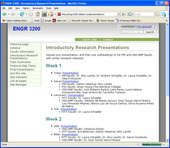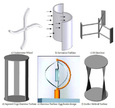Highlight
Communicating Across Borders: Enabling Interdisciplinary Sustainability Education and Research
Achievement/Results
Our Sustainability IGERT has worked to develop a graduate engineering curriculum that can teach scientists and engineers who conduct research into our essential infrastructures how to understand and work in other engineering disciplines. Community infrastructures sustain our high quality of life and also define it. Each infrastructure – water, wired, transport, buildings and community design/engineering, and nature itself – is fully interrelated. Each disciplinary expertise associated with an infrastructure needs to be both leader and responder to the experts of other infrastructures for a new generation of professionals and inventions to be able to develop. Professionals from a range of disciplines must learn how the various infrastructures are interrelated and how to use principles of sustainability in their design innovations.
The first step in achieving this vision is to produce PhD graduates with a common frame of reference with respect to sustainable engineering. We have created an Introduction to Sustainable Engineering course that all IGERT students take during their first term. This class covers topics that include life cycle analysis; environmental costing; regulatory framework in the US, European Union, and Japan; global and legal issues; risk analysis; social and international implications of non-sustainable design; environmental management in industry; and ethics and the responsible conduct of research. The class also brought in students from a Department of Education funded GAANN grant, as well as general students interested in sustainability. This course has been offered two times, and has produced scholarly papers from the students in both offerings.
A newly-created capstone class (ENGR 3200: Engineering Sustainability: Capstone Definition) is the next step in teaching students to work across disciplines in pursuing sustainability research. The class was offered for the first time this year, and included students from Mechanical, Industrial, Chemical, and Civil and Environmental Engineering, and faculty instructors from Mechanical Engineering and Materials Science and Industrial Engineering. Students worked in teams of two, and created interdisciplinary research proposals suitable for submission to a federal agency. For the first draft of these proposals, students participated in a panel review session, similar to the panel reviews conducted by NSF. For the final proposals, an external panel of faculty reviewed the students’ work, and the students were also given the opportunity to “pitch” their proposal as if to a program manager or community council.
The syllabus for the class included topics that were designed to help students understand the formalities of their own and others’ academic disciplines, and the nature of grant funding in academia, government labs, and industry. Some topics were: * What does a successful grant proposal or Ph.D. dissertation look like in my department? * Statements of intellectual merit and broader impact * How will my proposal/research be reviewed? * Project management
Even more important than these lecture topics, however, were the class discussions. Students were forced to examine the inherent assumptions made by each of their disciplines, and to learn how to clearly explain those assumptions to others with dissimilar backgrounds. Whether working with community leaders to install better environmental sensors in buildings or proposing a novel rainwater treatment system in an academic proposal, the students came to understand that there is no virtue in obscuring fundamental science and engineering behind the buzzwords we all absorb in our unique discipline.
In addition to the engineering aspects of the class, students also learned how to create and administer a timeline for research, and the expectations for a new faculty member or project team leader. Furthermore, students learned how to work with industrial collaborators, and how to negotiate intellectual property.
As an example, from this first offering of ENGR 3200, four grant proposals were generated. The topics of these proposals were: * Optimization of Thermoacoustic Engines – the application of novel optimization techniques to the development of a thermoacoustic Stirling heat engine and thermoacoustic refrigerators for higher efficiency and compact operation. * Integrated Sustainable Design: Biocomposite Panels – incorporation of natural fibers into a polymer blend matrix to make housing panels that are both comparably strong and environmentally superior to synthetic based composite materials. * In-Situ River Health Monitoring via a Sustainable Environmental Sensor – advancing remote unattended river water quality monitoring mechanisms through the development of a novel self-sustaining bio-electrical sensor coupled with a hydrokinetic energy extraction device. * Intelligent Design of Concentrating Solar Thermal-Photovoltaic Systems – application of product development metrics to the design process for high-efficiency solar systems, with a focus on both economic and environmental impacts.
In the near future, all of these proposals will be submitted externally. Target agencies include the National Science Foundation, the Environmental Protection Agency, and the Department of Energy. In order to increase the dissemination of our course materials, and to encourage on-line interaction with the students, we have created a wiki page for the class, which can be accessed at http://engr3200.wikidot.com.
Address Goals
By teaching students to communicate across their traditional disciplinary boundaries, those students can gain an appreciation for the impact of their own discipline, and the potential for greater good achieved by working with others of dissimilar background. These students can help to catalyze change in an area (greening our nation’s infrastructures) where progress has advanced in a very slow manner.










